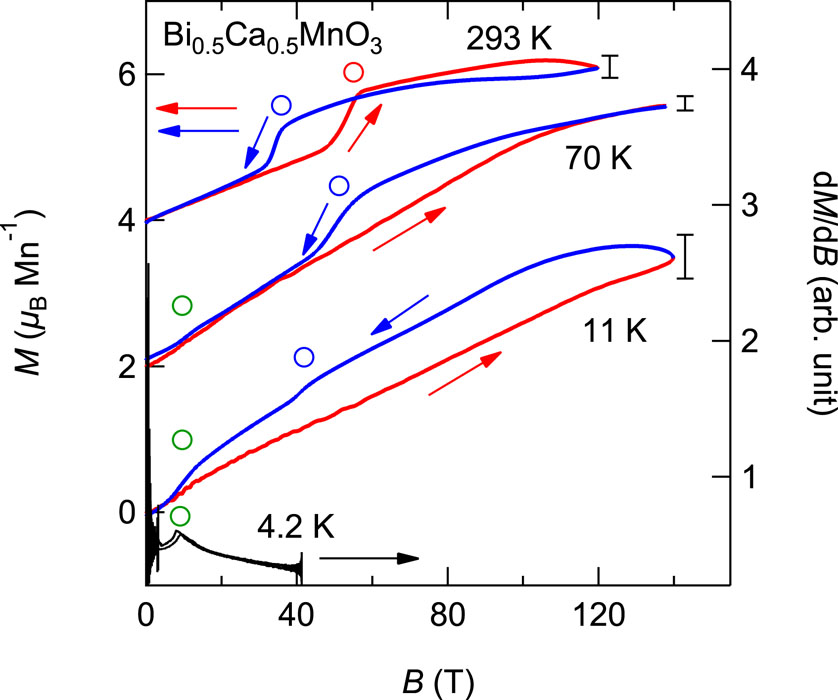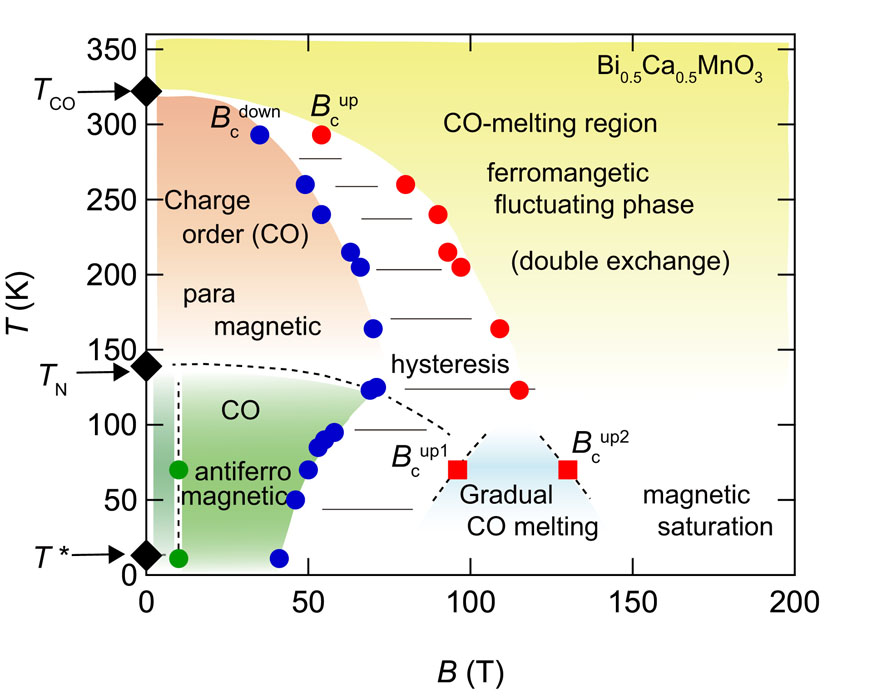Gradual Charge Order Melting in Bi0.5Ca0.5MnO3 Induced by Ultrahigh Magnetic Fields
Y. H. Matsuda Group
Perovskite-type manganite series AMnO3 (A = non magnetic ion) is the long standing one of the central subjects in condensed matter physics. Because of the coupling among the spin, charge, and orbital degrees of freedom, a lot of abundant exotic physical phenomena appear.
Electronic ground state of perovskite-type manganites is determined by the balance of the several interactions such as the Jahn-Teller coupling, on-site and inter-site Coulomb repulsion, superexchange interaction, and double exchange interaction.
Magnetic field effect on the ground state is significantly important subject in the perovskite-type manganites. The melting of the charge ordered (CO) state by applying magnetic fields is one of the central issues. This CO melting phenomenon sometimes accompanies the giant resistance change which is known as the colossal magnetoresistance.
The CO state in the perovskite-type manganites including Bi ions as A site (Bi1-xAExMnO3 ; AE = Ca or Sr) is more stable than that in the manganites including rare earth ions as A site (Ln1-xAExMnO3 ; Ln = rare earth element). The transition temperature of CO in Bi0.5Ca0.5MnO3 (TCO = 322 K) is higher than that in most of the rare earth systems with x = 0.5. The detailed investigation of the magnetic field effect on the CO phase in perovskite-type manganites with Bi ions would be interesting. However, the ultrahigh magnetic fields exceeding 100 T are needed for that investigation [1,2].
In this research [3], we tried to reveal the magnetic properties of Bi0.5Ca0.5MnO3 under ultrahigh magnetic fields by means of the magnetization measurements up to 140 T over a wide temperature range from 11 to 293 K. We prepared the single crystals by Bi2O3 flux method, and the sample characterization was performed by XRD, SEM, and magnetic susceptibility measurement by MPMS. The powder sample prepared by crushing and grinding the obtained crystals was used for the magnetization measurements.
We revealed that the CO in Bi0.5Ca0.5MnO3 can be melted by applying the magnetic field at the room temperature (293 K) (Fig. 1). It is observed as the metamagnetic transition. At low temperatures, the CO melting phase transition in the field ascending process becomes broad. However, the CO reformation can be observed clearly in the field descending process (Fig. 1). This asymmetric broadening phenomenon can be understood by the gradual CO melting induced by the ultrahigh magnetic fields.

Fig. 1. Magnetization curves at 293 K (up to 120 T), 70 K (140 T), and 11 K (140 T). Red and blue lines represent the field ascending and descending processes, respectively. Black line is the dM/dB at 4.2 K up to 40 T measured by the nondestructive method. Critical fields are marked by red and blue open circles in the field ascending (Bcup) and descending processes (Bcdown), respectively. Green open circles mark the critical field of the metamagnetic transition which appears around 10 T below TN. The estimated error bar is shown for each measurement.
This asymmetric broadening of the CO melting is possibly explained by the spatial inhomogeneity of charge distribution. In perovskite-type manganites, a spatial inhomogeneity of charge distribution the one of the attractive subjects and the important factor for the electronic ground state and phase transitions. The spatial inhomogeneity will be frozen by decreasing temperature, therefore the phase transition can be broad in the field ascending process. On the other hand, the spatial inhomogeneity will become less because the electron becomes itinerant in the CO melting region under the ultrahigh magnetic field. As a result, the metamagnetic transition can be sharp in the field descending process.
Another possible reason related to the slow dynamics is the critical slowing down owing to the quantum criticality of antiferromagnetic order.
Finally, we constructed the B-T phase diagram of Bi0.5Ca0.5MnO3 (Fig. 2).
For further investigation of the unusual CO melting phenomenon, the magnetostriction, resistivity, and XRD measurement under ultrahigh magnetic fields will be performed.
References
- [1] A. Kirste et al., Phys. Rev. B 67, 134413 (2003).
- [2] S. Takeyama et al., J. Phys. Soc. Jpn. 81, 014702 (2011).
- [3] Y. Ishii, A. Ikeda, M. Tokunaga, K. Kindo, A. Matsuo, and Y. H. Matsuda, J. Phys. Soc. Jpn. 92, 074702 (2023).

